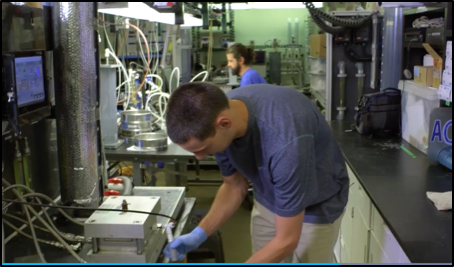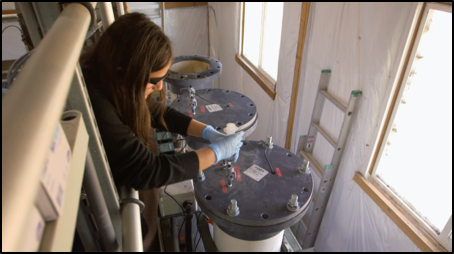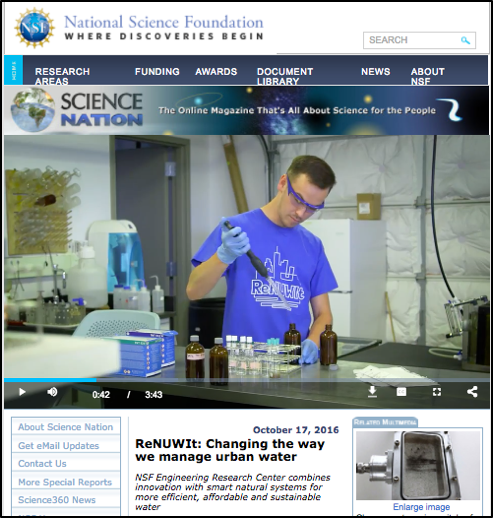Highlights
Sixth-Year
Below are highlights from ReNUWIt's Sixth-Year Annual Report (April 2017).
- Infrastructure: A Testbed for Innovative Water Technologies
- Infrastructure: A Living Levee that Protects Coastal Communities and Improves Water Quality
- Innovation: ReNUWIt Researchers Receive Award for Nitrogen Recovery Systems
- Technology Translation: ReNUWIt Brings Water Leaders Together to Envision Resilient Water Supply through Combined Stormwater and Recycled Water Recharge
- Education: ReNUWIt REU Participants Featured in Science Nation Video
Infrastructure
A Testbed for Innovative Water Technologies
Outcome/Accomplishment. In October 2016, construction was completed on the Codiga Resource Recovery Center (CR2C). The CR2C will serve as a testbed for multiple technologies developed by ReNUWIt, its IAB partners and other innovators. The center, which was funded in part through a gift to Stanford University, is a key element of ReNUWIt’s strategy to translate its research into practice. Technologies currently being tested include the new Staged Anaerobic Fluidized-Bed Membrane Bioreactor (SAF-MBR)—a technology that plays a key role in ReNUWIt’s efforts to advance energy and resource recovery from municipal wastewater—and the BioCHARGE geomedia system for stormwater treatment.
Impacts/Benefits. CR2C will accelerate the deployment and adoption of innovative water technologies by demonstrating them at credible scale, and reduce barriers to adoption by providing a low-risk, objective environment where stakeholders can assess the performance of new approaches for urban water management. In addition to providing a venue for research and development, CR2C draws attention to ReNUWIt’s vision for reinventing urban water systems and provides educational experiences for K-12 students, university students and water professionals.


Infrastructure
A Living Levee that Protects Coastal Communities and Improves Water Quality
Outcome/Accomplishment. In the Spring of 2016, a team that included ReNUWIt researchers, industrial advisory board members from the Bay Area Clean Water Agencies (BACWA), consulting engineers and non-governmental organizations opened a valve that introduced municipal wastewater effluent into the subsurface of a series of wetland cells. The Horizontal Levee (also known as the Living Levee) is a new approach for removing nitrate and other contaminants from wastewater effluent while simultaneously creating a wedge of land that can protect flood control levees from storm surges. The $5.3 million test facility (oroloma.org/horizontal-levee-project/), which is located in San Lorenzo, CA was built with funds from the utility and an integrated water resources planning grant administered by the San Francisco Estuary Partnership. The design team received the 2017 “Bay Hero” award from The Bay Institute (thebayinstitute.org/page/detail/16543).
Impacts/Benefits. The project provides a new strategy for addressing threats posed by sea-level rise, nutrient pollution and the disappearance of habitat. The test facility will provide important data on the design, operation and maintenance of full-scale horizontal levees. By engaging with community members, elected officials and government agencies, the team is diffusing the technology in the region and introducing this innovation to cities in regions facing similar issues.
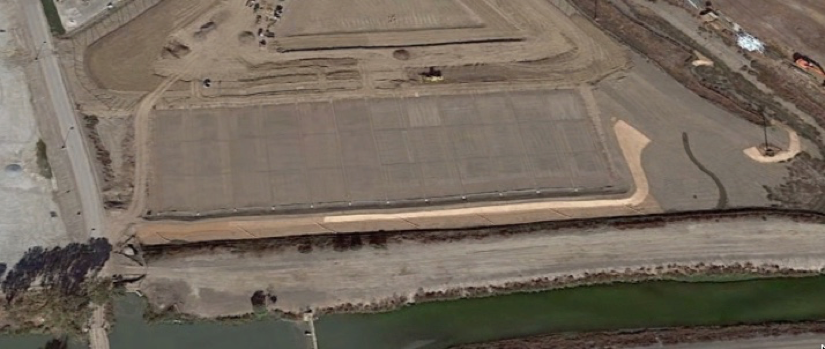
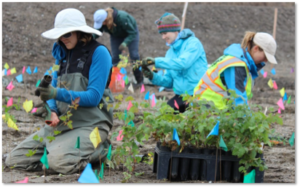
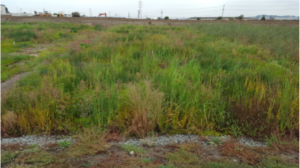
Innovation
ReNUWIt Researchers Receive Award for Nitrogen Recovery Systems
Outcome/Accomplishment. ReNUWIt researchers Will Tarpeh and Ileana Wald received the VentureWell (formerly NCIIA, National Collegiate Inventors and Innovators Alliance) E-team award (venturewell.org/student-grants/) for their ElectroSan technology in November 2016. The $5,000 award provides funding for immersive workshops and specialized coaching to student STEM innovators to help them move prepare for the Phase II competition and to move their inventions into the marketplace. The project helps advance research being conducted by ReNUWIt researchers and opens up potential applications in rapidly developing megacities. The team has begun to develop links to entrepreneurs in Dakar, Senegal, who are interested in applying the technology to recover nutrients from their network of waste collection stations.
Impacts and Benefits. When coupled with phosphorus recovery (e.g., by struvite precipitation) the nutrient recovery system provides income to support distributed sanitation efforts while simultaneously providing a less-expensive source of local fertilizers. Deployment of this approach could improve public health and advance development activities for millions of people worldwide. The process of creating a business plan and competing for funding also provided ReNUWIt students with valuable experience in diffusing technologies into practice.


Technology Translation
ReNUWIt Brings Water Leaders Together to Envision Resilient Water Supply through Combined Stormwater and Recycled Water Recharge
Outcome/Accomplishment. In March 2017, ReNUWIt researchers and the Southern California Water Committee organized a meeting of 22 leaders representing 6 major Southern California water utilities to discuss a ReNUWIt-developed decision-support tool that facilitates the planning of groundwater recharge projects that infiltrate stormwater and recycled water at the same location. The combined operation takes advantage of unused recharge capacity in existing spreading basins. ReNUWIt’s tool will allow water planners to identify optimal system designs with greater certainty and comprehensiveness. ReNUWIt grew its industry support to expand its modeling and analysis of these groundwater recharge systems beyond the City of Los Angles to the Greater Los Angeles region that serves 10 million residents.
Impacts/Benefits. In addition to building support for application of ReNUWIt’s tool, the meeting promoted a systems-level vision for enhancing urban water resilience through integrated reuse of stormwater and recycled water. The tool enables water planners to make informed decisions about their options for meeting water needs using local supplies.


Education
ReNUWIt REU Participants Featured in Science Nation Video
Outcome/Accomplishment. Three ReNUWIt Research Experience for Undergraduates (REU) participants – Jennifer Feigin, Elliot McCandless, and Conner Murray – were featured in a three-minute Science Nation video, alongside professors John McCray and Junko Munakata-Marr. The video, which is part of the NSF’s on-line science magazine, was featured on the NSF homepage banner, and was played on the 5th floor of NSF Headquarters in Washington, DC. In addition to the REU Program, the video highlights the ReNUWIt testbed at Mines Park.
Impact and Benefits. The ReNUWIt REU Program provides students with hands-on research experiences using cross-disciplinary, systems-level approaches that directly address the design of urban water infrastructure and key knowledge gaps in water science and engineering. The program also aims to increase undergraduate students’ interests in pursuing advanced degrees in water science/engineering, with a particular emphasis on women and minority students. The Science Nation video, which has reached thousands of aspiring, young engineers, helps increase awareness of the program through wide access channels.
